THE HARLEQUIN, THE BOX: CONCEITS OF ALIENATION IN THE
RECENT WORK OF KURT SCHRANZER by Meredith Morse
Article from Out: A Journal of Gay and Lesbian Art, No.1
Spring 1990
|
|
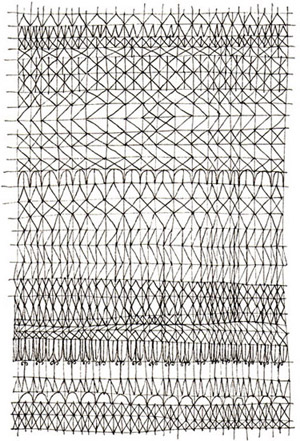 |
Compressed
Harlequin
1990, pen on paper, 23 x 16.25 cm
Signed and inscribed front with title, date, catalogue no. CMXXV |
|
The
Harlequin The Box
Conceits of Alienation in the Recent
Work of Kurt Schranzer
Kurt Schranzer's recent paintings, on view during July at The
Works Gallery, are small, meticulous still-life and landscape-referenced
tableaux composed of odd objects and geometric and architectural
constructions that structure ironic, open-ended inquiries into
the problematic of an obsessively self-reflective sexual identity.
These works are tiny, precious; they are presented within ornate
escalloped gold and faux-marble frames which situate their object
nature as parodic of bourgeois decorative preferences. A deliberate,
exaggerated 'tastefulness' allows these works to be envisioned
in rich, comfortable surrounds, under their pretext as decoration.
At the same time, their surrealist-informed content undermines
their formal placement. These works function as fetishistic accumulation,
in which libidinally invested forms supplant the more apparently
''neutral'' forms in de Chirico, one of Schranzer's sources of
parody and appropriation. Picasso's surrealist distortions of
the human form, such as the Anatomy series of drawings and the
etching Model and Fantastic Sculpture of the 1930s, in
which body members are substituted for others as well as distorted
and phallicised, provide a closer correlate and model for Schranzer's
organization of form (1). His concern with quizzical sexual and
literary object metaphors overloads their object bearers by hyperfetishing
them: by forcing more readings than the objects can sustain, fetishism
is parodied while at the same time its materiality is indulgently
portrayed.
|
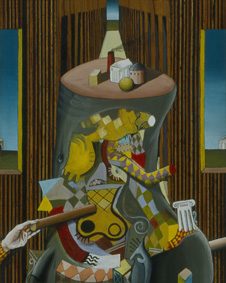 |
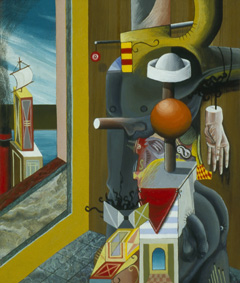 |
Harlequin,
Metamorphosing
1990, acrylic on wood veneer on panel, 23 x 18 cm
Signed and inscribed reverse with title, date, catalogue no.
DCCCXVII |
Salut
Matelot!
1990, acrylic on canvasboard, 19.2 x 16.4 cm
Signed and inscribed reverse with title, date, catalogue no.
DCCCXXVI |
|
In Harlequin Metamorphosing,
a small still-life of architectural Platonic solids rests upon
a truncated torso-figure which, Archimboldesque, is constructed
almost wholly of collaged cubist and surrealist derived forms.
Flattened checkerboard patterning refers to the Harlequin, whose
hand can be seen inserting a cylindrical penis-form into the composition
over a stylized Picassoid scrotum. Repeated scroll or G-clef shapes,
while referring to the cubist use of musical instruments as subject
matter, can also signify the anus, according to Schranzer. Sets
of curved or straight lines are equally referential to Picasso's
calligraphic shorthand for hair or features in his surrealist-influenced
figurations, as they are to pubic hair, and body hair in general.
A similar clustering of devices occurs in Salut Matelot!,
titled after the French for ''hello sailor,'' as a reference both
to Genet's Querelle of Brest and to the positioning of
the sailor as a male culture stereotype of the sexual. The central
figure, composed of still-life groupings, body parts, and opened-out
box forms, was originally conceived as a suspended mobile, according
to Schranzer. The logic of such an organization, coupled with
Schranzer's appropriation of Picasso's surrealist approach to
the manipulation of the body, dictates an organic, clustered structure
of accumulated parts which is never completed, but can accommodate
new growths, polyps, permutations.
|
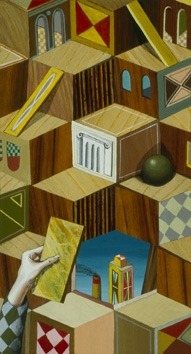 |
The
Architect's Failure alludes in title and structure
to an authorial desire for closure, which is never attained.
The hand of the author or architect, and, by implication,
the hand of God, seeks to organize and contain an ordered
landscape of wood veneering and Harlequin motley, which extends
infinitely off the panel in all directions. Yet, a gaping
hole, created by the absence of the pattern itself, punctures
the ordered world (to the surrealists, the world of social
nicety and repression) to reveal a limitless sky and a phallic
smokestack. Within the level of the ordered pattern, only
small doorways are provided as an escape from the relentlessness
of regulation, but they too are devised by the author, which
seeks to cover up the irregularity of the hole to the outside.
From the title of the piece, and in the terms in which the
surrealist project of releasing the unconscious from its Oedipalised
constraints is phrased, the architect (wearing Harlequin motley)
would never conclusively define the subject it attempts to
order.
In its literal shallowness, veneer is used to refer to the
contrast of the fictive, illusionistic space of the painting,
with the decorative actuality of surface: this liberalizes
the nature of repression as masking, parodying the surrealist
project as simplistic. Schranzer's love of surface, whether
as actual veneering or as carefully rendered faux-marble in
painting or frame, contributes self-consciously to a positioning
of the fetishism of order against the chaos of the felt experience
of the fragmented self. But, more than this, his project specifically
investigates the subjectivity of the gendered, male, self,
as it attempts, from a decentred position or range of positions,
to define itself, and to perceive itself in tentative relation
to a love-object. |
The Architect’s Failure
1990, acrylic on wood veneer on panel, (size not recorded) cm
Signed and inscribed reverse with title, date, catalogue no.
DCCCXV |
|
| In his drawings,
Schranzer's use of line is reminiscent of early Warhol (2). It is
arch, deliberately imprecise, and eloquently obsessive. Schranzer's
blotted-line drawings are posed and playful, like Warhol's, though
their serious-but-innocent-treatments borrow style from Klee. His
figurative posings are loose, like Klee's line, but highly self-conscious
as in Cocteau. All pertain (and, as it were, are stripped bare by
the skeletal, definitive line) to the problematic of selfhood: Schranzer's
device of the box-emblem for his self enables him to literally
skirt around the perimeter of this problematic, without attempting
to fix or concretise it. In a sense, these pieces are organized
around open-ended narratives which hint at melancholy tales, romantic
meditations upon love longed for and lost. But the narratives end
at their beginnings: the stage is set, the Harlequin has been given
his lines; but the remainder of the scene is unclear, informed by
a pathos which foresees a sad ending anyway.
|
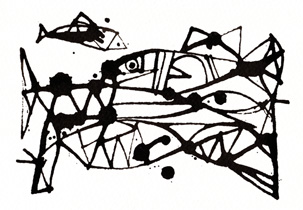 |
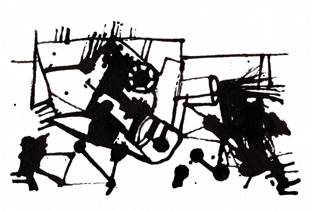 |
Conversation
Between Many Fish
1990, ink on paper, 16.25 x 23 cm
Signed and inscribed front with title, date, catalogue no. CMXV |
Francis Slips
with the Fret-Saw while Sculpting
1990, ink on paper, 16.25 x 23 cm
Signed and inscribed front with title, date, catalogue no. CMXXXVII |
|
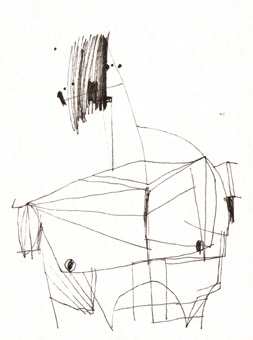 |
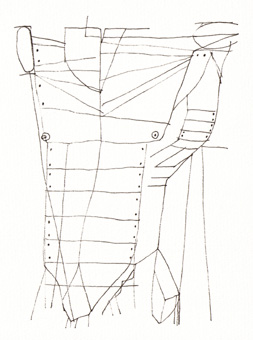 |
Boy with
Muscles
1990, pen on paper, 18 x 12.7 cm
Signed and inscribed front with title, date, catalogue no. DCCCLXXX |
The Seven
Deadly Sins: Steel-Plated Pride
1990, pen on paper, 18 x 13.3 cm
Signed and inscribed front with title, date, catalogue no. DCCCXXXI |
|
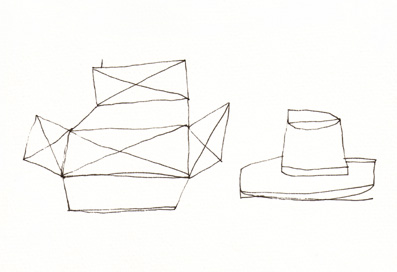 |
Box
drawings which show a literal opening-out of the box to
signify a receptive opening of the self, such as in Opened
Out Self-Portrait with Francis, posits an equation
of containment with reception: both box-forms and architectural
conceits are devices that function to order, restrict, and
contain, and are thus congruent with signifiers of repression
in the surrealist lexicon: but, as Schranzer's project adds
the nexus of subjectivity/ sexuality/relation-to-another
(which can be seen as the terrain of the sexually marginalised),
these devices make the boxes and architectural forms reinterpretable
as not simply machines for repressive constraint and containment,
but as containers, receptacles, receivers. The prompter
in Still-Life With Prompter's Box is gagged —
filled — with a penis-cylinder which his mouth receives
and which renders him mute. In the love relationships Schranzer's
work speaks of, the partner who receives, who appears to
be acted upon, is caught in flux, without the definitively
demonstrable act of doing to fix his identity: his position
is elusive, changeable: perhaps it is up-speakable, mute.
To call this position ''passive'' is to miss, first of all,
the subtleties of exchange, in favour of the certainty of
a dichotomous structuring which mimics the supposed complementarity
of heterosexual relationships. Secondly, such a position
can be adopted strategically, playfully, or ecstatically:
it does not necessarily or ultimately stand as a subservient
position of humiliation, lack, or even of alienation, though
this last is part of Schranzer’s project. |
Opened
Out Self-Portrait with Francis
1990, pen on paper, 13.3 x 18 cm
Signed and inscribed front with title, date, catalogue no.
DCCCXIX
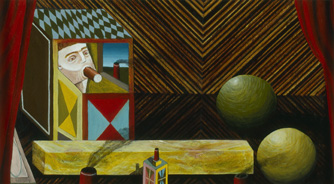
Still-Life with Prompter’s Box
1990, acrylic on wood veneer on panel, 13.5 x 24.5 cm
Signed and inscribed reverse with title, date, catalogue no.
DCCCXXI |
|
Both in his paintings
and drawings, Schranzer offers up colourful, beautifully rendered
image-playthings to distract us from the pain of self-distantiation
and its corollary, self-scrutiny. This examination of the self —
a look at once fascinated, fixated, and pained; oblique, and precise
— speaks of loss and melancholic abandonment. The need to
articulate and fix the self is paralleled closely with the desire
to be hidden, to become an object, a box, or a toy. This dialogue
of the seeking self with itself — or the self with an objectified
other persona which speaks in the guise of a (fragmented) other,
such as the Harlequin, Minotaur, or schizophrene — desires
the establishment of an identifiable integrated self, at the same
time that it denies that this is possible, and seeks to obliterate
the inauthentic self that is posited in the authentic self’s
absence. Ultimately, all that is left is the false and familiar;
the known, fragmented self of everyday knowledge, which, to this
sensibility, preserves enough of prelapsarian perfection and wholeness
to be an intolerable reminder of what one is not, yet which one
longs to be or to love in one's own sex, as in a mirror. |

Decapitated
Man as a Greek Temple
1990, ink on paper, 23 x 16.25 cm
Signed and inscribed front with title, date, catalogue no. CMXIX
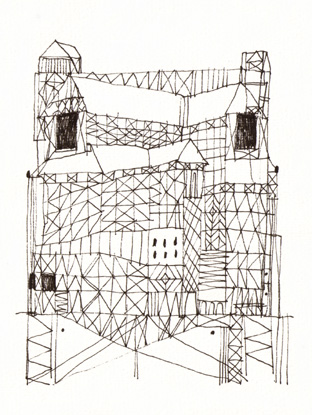
Harlequin
Disguised as a Tudor House
1990, pen on paper, 18 x 13.3 cm
Signed and inscribed front with title, date, catalogue no. DCCCXXXVIII
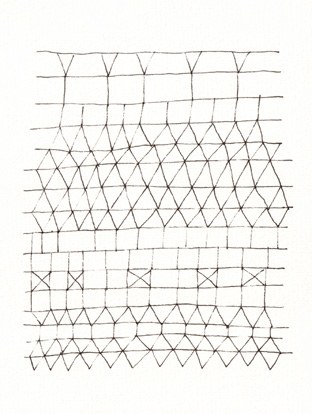
Harlequin
in a String-Bag
1990, pen on paper, 18 x 13.3 cm
Signed and inscribed front with title, date, catalogue no. DCCCXXXXIV
|
For
Schranzer the aesthetic ideal, for which the fragmented, imperfect
self yearns is one of a classical purity, an originary unity
and wholesomeness: the boyish, fresh, yet precocious beauty
of the ancient Greek kouros and Roman profile, whose
posture is strong and heroic; whose torso is triangulated,
classicised, as in the photography of Bruce Weber, and that
of Herb Ritts; whose mouth, over a curving jaw, is pouty and
voluptuous. Like the Diskobolos, this figure must
be graceful and lithe; must be mercurially charming and elusive
like Puck; and stylish, fey, yet potent, as are the hommes
fatals of Cocteau's drawings. Though this figure of aesthetic
perfection is integral to Schranzer's conceptualising as a
whole, it can be seen to inform his work most obviously in
terms of its effects upon emblematic structures signifying
Schranzer's self, which are implicitly positioned as its opposite;
and its manifestation in various ''youth'' drawings whose
subject is the sprite-like, palpably erotic presence of this
knowing, precocious boy. Columns and other architectural conceits
of ''the classical'' are used emblematically throughout Schranzer's
paintings and drawings to indicate the pervasiveness of this
aesthetic which functions as a reminder of this idealised
beauty, and as a reproach to the subject, which always falls
short of perfection according to this scheme. A true love-relation,
by this logic, can only exist between idealised equals:
Thus, I began as a romantic idealist, seeking only the
perfect love. I looked for a companion who would be both brother
and lover, who would be a fellow explorer and sufferer, a
playmate to laugh and cavort with, a like-minded philosopher
to muse over humanity’s plight with. (3)
In Querelle of Brest, Lieutenant Seblon keeps a diary
in which he carefully records his most minute observations
of the matelot, Querelle. It is a litany of love, a hymnal
of yearning desire to the grace of Querelle's unthinking,
animal beauty; to the manner in which Querelle so easily and
naturally inhabits his own body. When Querelle meets Gil,
he feels as if he has met a ''minor Querelle'' an ''embryo
Querelle (4), and it is like kissing himself, his equal, when
they embrace. The Lieutenant is a man of duty, of artifice:
he marvels at Querelle because of his own self-consciousness.
He would never be a suitable lover for Querelle in terms of
this narrative of idealised love as mimesis; and indeed, though
Querelle is aware of and exploits the lieutenant's love, it
is never consummated. In fact, non-mimetic love in the narrative
is characterized by the exploitation of a power relation.
It is this inequality of power relations which the subject
in Schranzer's schema fears, in its longing for an authentic
love, and thus an authentic self.
The personae of the Harlequin, and to a lesser extent, the
Minotaur and the schizophrene, operate in Schranzer's work
to elaborate upon the project of the speaking of the fragmented
self. These figures in general conflate to signify the ridiculousness
and monstrosity of a self that must perform at the periphery
of social discourse.
In his Rose period, Picasso combined attributes of the Harlequin,
originally a theatrical figure, with that of the saltimbanque,
a street acrobat, and the jester or fool, the medieval court
figure of entertainment and ridicule. The resultant figure,
sometimes portrayed with Picasso's facial features as in At
the Lapin Agile, served as an alter ego signifying both
his peripheral position in society as an artist, and as a
barometer of his domestic happiness or alienation (5).
Picasso's Minotaur, unlike the terrifying figure of classical
mythology, is a vulnerable figure, a playfully comic grotesque
who, just as he is sexually potent in some representations,
is portrayed as vanquished and wounded in others, his symbolic
castration all the more pathetic because his awe-inspiring
strength. Picasso's inspiration for this alter ego figure
came from his frequent contact with the ritual of the corrida,
or Spanish bullfight (6). In the ring, the bull's natural
strength and courage were used against him, such that the
greater his fight against his fate, the greater would be his
eventual punishment by the toreador, whose role was to ritualistically
exhaust, wound, and kill the bull. According to Gloria Fiero,
Picasso saw himself as in this situation, as a bull-man or
Minotaur (7). In a stage curtain design for Le Quartoze
Juillet, Picasso portrays a limp, vanquished Minotaur,
dressed in Harlequin's motley, slumped in the arms of a muscular,
bird-headed monster. This defeated creature, conflated with
the alienated role of the Harlequin, stands for Schranzer
as a significant embodiment of the separate spheres of alienation
in which the fragmented self moves and finds itself. In an
earlier painting of Schranzer's he renders the Minotaur as
an armless, horned boy. The figure is maimed incomplete, broken.
Clearly, to operate at the periphery of subjectivity, particularly
sexual subjectivity here, is to risk dismemberment: to risk
not only the perception cast upon this subject as incomplete
or grotesque, but a symbolic castration that removes the subject
from membership in the symbolic order. The marginalised subject
perceived thus is not allowed the space in which to speak.
|
|
|
The marginalised
subject, negligibly placed at the fringe of mainstream social exchange,
is thus estranged from himself just as he is excluded from the socius.
The disallowing of a legitimised signifying framework impacts in
several ways. Only mainstream, and therefore dominant, discourses
are couched in terms of transcendental universalisms, characterised
at their normative point of origin by heterosexism as well as other
privileging determinants. All frames considered worthy of evaluation
(and the application of connoisseur-based objectives) must be seen
to occur within the mainstream for criticism, as such, to remain
operative. To step outside this, to make work labelled ''gay art''
is to risk its perception in terms of a categorizing of experience
generated by mainstream tactics of excising otherness from the body
politic. An internalisation of such projections upon the marginalised
can generate work in which stereotypes are investigated in terms
of the problematic of subjectivity. Such a self-reflective project
risks, in mainstream perception, being regarded as kitsch. Thus
''authenticity'' becomes, if the term can be used divorced from
an absolutist context, a measure of the extent to which one can
speak ''marginality'' with the tools at hand — recognizing
its construction as such — and yet still articulate the conditional
truths of felt experience.
Schranzer's work engages with this problematic by perceiving appropriated
forms, conventions, and personae as strategic devices which can
be utilized to establish a range of positions from which to speak
his particular subjective and social disenfranchisement. This usage
should not be considered completely isomorphic with concerns articulated
in the current ''mainstream'' of post-structural art practice, as
it engages as well with an aesthetic of male subjectivity that lies
outside it. What Schranzer's concern for the inner and the outer
of subjectivity indicates in these terms, is a need for interpretive
systems and forums which can accommodate the complex relations among
multiple mainstreams and margins, and provide an alternative
to extant dichotomising models.
NOTES
1. See John Golding's essay, ''Picasso and Surrealism,'' in Roland
Penrose and John Golding (Eds.), Picasso 1881/1973 (London:
Paul Elek Limited, 1973).
2. See Rainer Crone, Andy Warhol: A Picture Show by the Artist
(New York: Rizzoli International Publication, 1987), originally
pub. as Andy Warhol: Das zeichnerische Werk 1942–1975
(Stuttgart: Wurttembergischer Kunstverein, 1976), for a thorough
look at Warhol’s early graphic work.
3. Gary 'Wotherspoon, ''The Loner,'' in Gary Wotherspoon (Ed.) Being
Different (Sydney: Hale and Iremonger, 1986), p. 117.
4. Jean Genet, Querelle of Brest (London: Paladin Books/Collins
Publishing Group, 1987: first pub. in UK in 1966), p. 205.
5. For a discussion of the iconographic uses of the Harlequin figure
in Picasso, see the following by Theodore Reff: ''Harlequins, Saltimbanques,
Clowns, and Fools,'' Artforum (10:2, Oct 71): and, ''Love
and Death in Picasso's Early Work,'' Artforum (11:9, May
73).
6. See Roland Penrose, ''Beauty and the Monster,'' in Penrose and
Golding, op. cit.: and Gloria K. Fiero, ''Picasso's Minotaur,''
Art International (26:5, Nov 83).
7. Fiero, op. cit. |
|
|
| |
|
© Meredith Morse
1990 & Kurt Schranzer 2007 |
|

